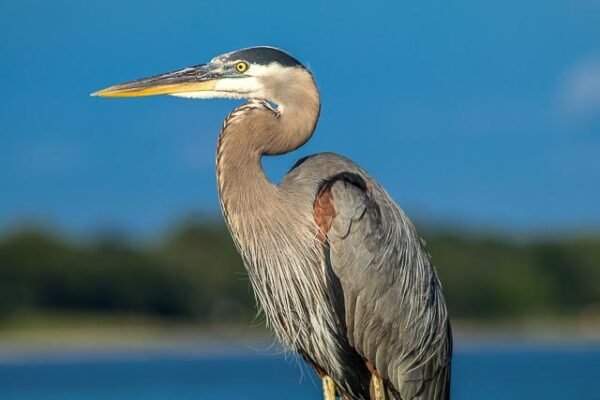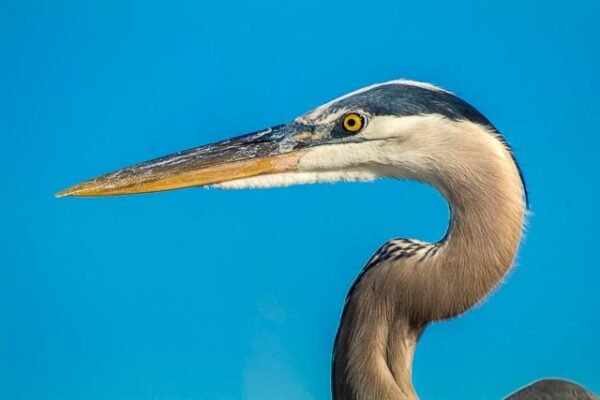Great Blue Heron October 2025 Bird of the Month
Each month I will feature a bird that I have photographed. Not only will I show some of my photos but will also include information about the bird.
The great blue heron (Ardea herodias) is a large wading bird in the heron family Ardeidae, common near the shores of open water and in wetlands over most of North and Central America, as well as far northwestern South America, the Caribbean and the Galápagos Islands.
The great blue heron is the largest heron native to North America. Among all extant herons, it is surpassed in size only by the goliath heron and the white-bellied heron. It exhibits a minor degree of sexual dimorphism; males are slightly larger than females, but otherwise the sexes are not easily outwardly distinguishable.
It has head-to-tail length of 36–54 in, a wingspan of 66–79 in, a height of 45–54 in, and a weight of 4.0–7.9 lb. Thus, great blue herons are roughly twice as heavy as great egrets, although only slightly taller than them, but they weigh only about half as much as a large goliath heron.
Notable features of great blue herons include slaty (gray with a slight azure blue) flight feathers, red-brown thighs, and a paired red-brown and black stripe up the flanks; the neck is rusty-gray, with black and white streaking down the front; the head is paler, with a nearly white face, and a pair of black or slate plumes runs from just above the eye to the back of the head.
The feathers on the lower neck are long and plume-like; it also has plumes on the lower back at the start of the breeding season. The bill is dull yellowish, becoming orange briefly at the start of the breeding season, and the lower legs are gray, also becoming orangey at the start of the breeding season. Immature birds are duller in color, with a dull blackish-gray crown, and the flank pattern is only weakly defined; they have no plumes, and the bill is dull gray-yellow. Among standard measurements, the wing chord is 16.9–19.4 in, the tail is 6.0–7.7 in, the culmen is 4.8–6.0 in, and the tarsus is 6.2–8.3 in. The heron’s stride is around 8.7 in, almost in a straight line. Two of the three front toes are generally closer together. In a track, the front toes, as well as the back, often show the small talons.
Distribution and habitat
The great blue heron is found throughout most of North America, as far north as Alaska and the southern Canadian provinces in the summer. In winter, the range extends south through Florida, Mexico, and the Caribbean to far northwestern South America. Birds east of the Rocky Mountains in the northern part of their range are migratory and winter in the coastal areas of the Southern United States, Central America, or northern South America. From the Southern United States southwards, and on the lower Pacific coast, they are year-round residents. However, their hardiness is such that individuals often remain through cold northern winters, as well, so long as fish-bearing waters remain unfrozen (which may be the case only in flowing water such as streams, creeks, and rivers).
The great blue heron can adapt to almost any wetland habitat in its range. It may be found in numbers in fresh and saltwater marshes, mangrove swamps, flooded meadows, lake edges, or shorelines. It is quite adaptable and may be seen in heavily developed areas as long as they hold bodies of fish-bearing water.
Great blue herons rarely venture far from bodies of water, but are occasionally seen flying over upland areas. They usually nest in trees or bushes near water’s edge, often on islands (which minimizes the potential for predation) or partially isolated spots.
Diet
The primary food for the great blue heron is fish. While they can prey on various sizes of fish from small fingerlings to large adult fish, measuring 24 in in length and weighing around 2.0 lb, small to medium-sized fish around 3.9–7.9 in are usually preferred. Primary prey fish is variable based on availability and abundance.
Besides fish, it is also known to feed on a wide range of prey opportunistically. Amphibians such as leopard frogs, American bullfrogs, toads and salamanders are readily taken, as well as reptiles such as small turtles, snakes and lizards. They can take on sizeable snakes, including water snakes 41 inches in length. Aquatic crustaceans (such as crayfish, shrimp and crabs), grasshoppers, dragonflies and aquatic insects are taken as supplementary prey. They also prey on small mammals including shrews, rats, ground squirrels, and moles.






